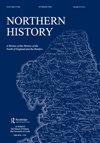柯林:公元580-950年北不列颠和威尔士的叙事与身份
IF 0.2
3区 历史学
Q2 HISTORY
引用次数: 0
摘要
对哈德良族谱(HG VIII-XII和XIX)中与“Coeling”谱系相关的寒武纪-拉丁语来源的研究强调了对哈德良边境地区在6世纪和7世纪的地缘政治采取修订观点的必要性。七世纪早期的诺森伯兰征服可能是一个更渐进的外交过程,而不是后来的资料,包括比德和《布里顿历史》所想象的那样。同样,这些文献可能过分强调了雷格德的霸权、乌里安王朝和六世纪后期的“盎格鲁战争”。最后,柯陵王朝本身是一个回顾性的捏造,它的组成部分似乎是宗谱上的,甚至在文化上是不相关的。我们在每个谱系的单一性特征中发现了这种多样性的暗示,以及在这些早期材料中隐含的相互冲突的王朝和地缘政治重点。这些坎布罗-拉丁语来源的独特和异质特征最好是根据与北方的真正联系来解释的,这些联系似乎在中世纪早期威尔士幸存的文本汇编中已经融合和融合。同样的趋势在与尤里安和他同时代的人有关的白话中也很明显,我们得出结论,这可能是通过同样的交流途径进行的。本文章由计算机程序翻译,如有差异,请以英文原文为准。
The Coeling: Narrative and Identity in North Britain and Wales AD 580–950
An examination of the Cambro-Latin sources associated with the ‘Coeling’ lineages in the Harleian genealogies (HG VIII–XII and XIX) underscores the need to take a revised view of the geopolitics of the Hadrianic Frontier region across the sixth and seventh centuries. The Northumbrian conquests of the early seventh century may have been a more gradual, diplomatic process than was imagined by later sources, including Bede and Historia Brittonum. Similarly, the hegemony of Rheged, the dynasty of Urien and the ‘Anglian Wars’ of the late sixth-century may have received undue emphasis by these sources. Finally, the Coeling dynasty itself emerges as a retrospective fabrication, whose component groupings appear to have been genealogically and even culturally unrelated in the first instance. We find a hint of this diversity in the onomastic character of each of the lineages, as well as the conflicting dynastic and geopolitical emphases implicit in this early material. The distinct and heterogeneous character of these Cambro-Latin sources are best accounted for in terms of genuine connections to the North, which appear to have converged and syncretised in the surviving text compilations from early medieval Wales. The same tendencies are apparent in the vernacular hengerdd material and saga englynion concerned with Urien and his contemporaries which, we conclude, were probably mediated through the same lines of communication.
求助全文
通过发布文献求助,成功后即可免费获取论文全文。
去求助
来源期刊

Northern History
Multiple-
CiteScore
0.20
自引率
33.30%
发文量
37
期刊介绍:
Northern History was the first regional historical journal. Produced since 1966 under the auspices of the School of History, University of Leeds, its purpose is to publish scholarly work on the history of the seven historic Northern counties of England: Cheshire, Cumberland, Durham, Lancashire, Northumberland, Westmorland and Yorkshire. Since it was launched it has always been a refereed journal, attracting articles on Northern subjects from historians in many parts of the world.
 求助内容:
求助内容: 应助结果提醒方式:
应助结果提醒方式:


